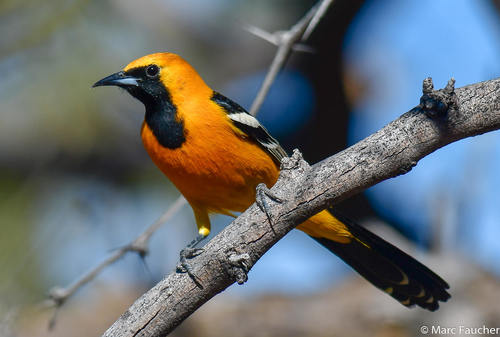
Hooded Oriole
The Hooded Oriole (*Icterus cucullatus*) is a striking, medium-sized New World oriole known for its vibrant coloration and intricate nests. It plays a crucial role in its ecosystem as both a seed disperser and an insect predator. Found across a wide range of habitats, from the southwestern United States to Mexico and Belize, it is a familiar sight in many suburban and rural areas. While not currently of major conservation concern, it faces threats from habitat loss and brood parasitism.
18-20 cm
Length
23-28 cm
Wingspan
Least Concern
Conservation Status
Distribution
The Hooded Oriole's range extends from the southwestern United States (California, Nevada, Arizona, New Mexico, and Texas) south through Mexico and into Belize. Migratory populations breed in the northern parts of the range and winter in Mexico. They are generally found at lower elevations.
Lifespan
The average lifespan in the wild is unknown, but they can live at least 6 years.
Hooded Oriole's Habitat
Habitat Types
Riparian woodlands, Palm groves, Suburban gardens, Open woodlands, Mesquite thickets
Climate Zones
Subtropical, Temperate, Arid
Adaptations
Hooded Orioles have adapted to a variety of habitats, showing a preference for areas with tall trees, particularly palms, for nesting. Their strong bills are well-suited for foraging on a variety of food sources.
Variations
Several subspecies are recognized, differing slightly in plumage color and size. For example, *I. c. nelsoni* in California tends to have more orange plumage than the more yellow *I. c. sennetti* found in Texas.
Appearance
Breeding Plumage
Adult males have a black throat and face (the 'hood'), a black back, wings, and tail, and orange or yellow underparts. Females and immatures are duller, with olive-green upperparts and yellowish underparts. There is little seasonal variation in plumage beyond the general brightening of colors during the breeding season.
Seasonal Feather Changes
Limited seasonal variation. Molting occurs after the breeding season.
Sex Based Plumage Differences
Significant sexual dimorphism. Males are brightly colored, while females are much duller.
Notable Features
Black 'hood' on males, Long, pointed bill, Orange or yellow underparts (depending on subspecies), White wing bars
Diet and Feeding
Primary Foods
Insects, Spiders, Nectar, Fruits, Berries
Foraging Behavior
Hooded Orioles are active foragers, gleaning insects from leaves and branches, probing flowers for nectar, and sometimes catching insects in flight. They are also known to visit hummingbird feeders.
Specializations
Their pointed bill is well-suited for probing into flowers and extracting insects from crevices. They often hang upside down to reach food.
Seasonal Diet Variations
Their diet shifts with the seasons. During the breeding season, they consume more insects to feed their young. In the winter, they rely more on fruits, berries, and nectar.
Behavior
Social Structure
Hooded Orioles are generally solitary or found in pairs during the breeding season. Outside of the breeding season, they may form small flocks.
Communication
A variety of calls, including a whistled 'wheet', A harsh chatter, A complex song used by males to defend territory
Migration
Northern populations are migratory, flying south to Mexico and Central America for the winter. Southern populations may be resident year-round.
Territorial or Group Behaviors
Males are territorial during the breeding season, defending their nesting area from other males. They are known to be aggressive towards other oriole species.
Conservation
Threats
Habitat loss (particularly the loss of palm trees and riparian areas), Brood parasitism by Brown-headed Cowbirds, Pesticide use, Climate Change
Protection Programs
Habitat restoration projects, Cowbird control programs (in some areas)
Local National Laws
Protected under the Migratory Bird Treaty Act in the United States.
Population Trend
Stable
Population Estimates
The global population is estimated to be around 5.8 million.
Interesting Facts
They often weave their nests into palm fronds.
This provides a secure and well-hidden location for their young.
They are known to steal nesting material from other birds' nests.
This saves them time and energy during nest construction.
Hooded Orioles have been observed using tools.
There are reports of them using plant fibers to stitch together leaves to create a more secure nest.
Faqs about Hooded Oriole
What should I do if I find a baby Hooded Oriole?
If the bird is uninjured and appears healthy, it is best to leave it alone. The parents are likely nearby and will continue to care for it. If the bird is injured or in immediate danger, contact a local wildlife rehabilitator. Consult a professional for medical or expert advice.
How can I attract Hooded Orioles to my yard?
Planting native trees and shrubs, especially palms, can provide nesting sites and food sources. Providing a source of fresh water and offering nectar feeders can also attract them.
Are Hooded Orioles aggressive?
Males can be aggressive towards other males and other oriole species during the breeding season, but they are not generally aggressive towards humans.
Copyright @ Nature Style Limited. All Rights Reserved.
 English
English